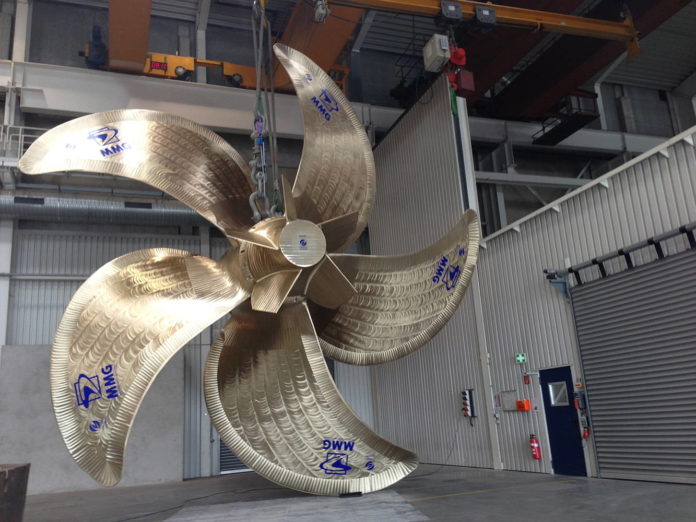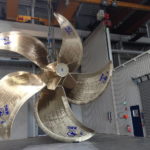
A re-design of a propeller can lead to energy savings of up to 10 %. Mecklenburger Metallguss (MMG) has done intensive research in this field, followed by a pilot
project, which is described by
The international shipping market still suffers from overcapacities and charter rates at [ds_preview]a very low level. Beside all the older vessels in service, shipowners have ordered many newbuildings in the last years. But these vessels are often based on specifications according to operational profiles previous to the economic crises and therefore do not represent actual requirements. Many of these vessels operate in slow and ultra-slow steaming.
This leads to new developments in the field of re-design and retrofit. In addition to modifications of local hull shapes (bulbous bow) and the consideration of propulsion improving devices there is already awareness that the re-design of the propeller can be quite profitable. According to original configurations savings due to an optimised propeller can be between 3 and 10 %.
Lowering of maximum permissible power
The specific increase in efficiency mainly depends on the performance of the original propeller and the actual operational profile. Here the decrease in maximum speed gives an additional freedom to the new design. New design opportunities mainly are based on the lowering of the maximum permissible power. As experienced in many re-design projects the new power limit typically is about 65 % of the original main engine power. Due to the constantly high fuel prices a tendency back to higher vessel speeds seems to be very improbable.
Within the last year Mecklenburger Metallguss GmbH (MMG) carried out several re-design studies on behalf of different shipowners. Based on the provided shipping data and on the new operational profile of the vessel, the design of an optimised propeller was the focal point.
Pilot project with post-panmax container vessels
As a pilot project MMG analysed an existing propeller design for post-panmax container vessels already under construction. The vessels were equipped with newest ultra low speed engines with nominal shaft speeds of 78 rpm. As MMG had already designed propellers for similar configurations the analysis was based on good experience with efficient slow running propellers. The pre-calculations showed a significant saving potential.
Thus, MMG carried out comparative model tests at Potsdam model basin. The tests confirmed a reduction in power demand of 8–9 %, considering the same vessel speed (see table 1). The improvement results from increased propeller efficency and a better interaction between propeller und hull. Additional cavitation tests showed a lower vibration level for the re-designed propeller.
Based on the results new propellers were ordered at MMG to exchange the original ones. For a full scale verification the first vessel fulfilled sea trials with the original design as the second hull number sailed with the new MMG design. The measurements on these comparative trips confirmed the differences recognised in the model tests.
MMG executed the design and prediction methods used for this project within several re-design projects based on slow steaming operation. In spring 2013, MMG designed new optimised propellers for a series of post-panmax container vessels. After successful model tests with improvements of 7–10 % depending on speed MMG now manufactures new propellers for the whole series.
Additional savings through special fin caps
In addition to these highly efficient propellers, special fin caps will be installed at these vessels (see photo right). These in-house developed ESCAPs are based on well-known working principles but with further improvements due to CFD-related optimisations. The energy saving caps reduce hub vortex losses and regain some positive torque.
Beside this project already in manufacturing, MMG carried out model tests for several re-design projects with measured savings of 3–9 % in the direct propeller-propeller comparison and of 2–3 % for the ESCAP.
In order to ensure that these optimum propeller geometries tested in model scale will lead to the same improvements in full scale, MMG introduced newest optical measurement systems within manufacturing and quality check. These systems support the adjustment of new propellers to an already installed shaft line. This technology also helps to reduce docking time.
The propeller exchange, often combined with modifications of the bulbous bow, shows a very short return of investment. As the costs for the material of the new propeller in principle are covered by the material of the original propeller, only the manufacturing costs have to be considered. And these costs are compared to the expectable savings quite low – the payback rather short.
Author:
Dr.-Ing. Lars Greitsch
Head of Research and Innovation
Hydrodynamic Propeller Design
Mecklenburger Metallguss GmbH, Waren
greitsch@mmg-propeller.de
www.mmg-propeller.de
Lars Greitsch




















